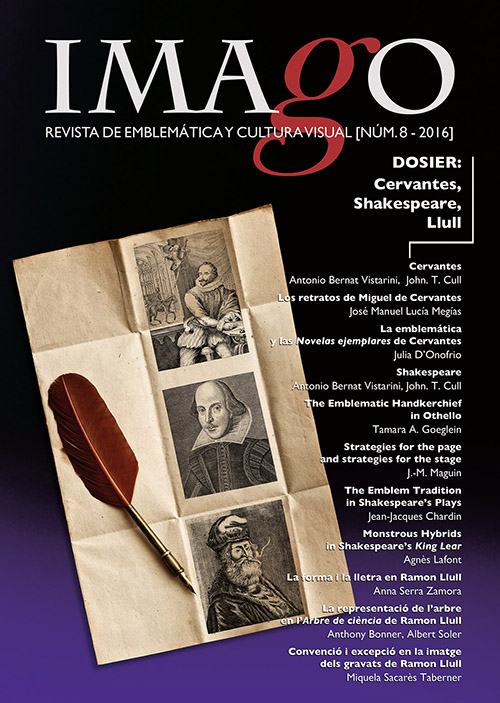Monstrous Hybrids in Shakespeare’s King Lear
DOI:
https://doi.org/10.7203/imago.8.8460Keywords:
emblems, drama Abstract
Abstract
ABSTRACT: This article seeks to present the different languages (emblems, Renaissance translations of classical myths, biblical exegesis) that inform the images of monsters which, as hybrid creatures blending human and animal characteristics, serve a dramatic function in Shakespeare’s King Lear. It means to question the ways in which the play links filial ingratitude with female monstrosity and Lear’s madness. Tracing the classical and medieval lineage of the monstrous bestiary (serpent, tiger, vulture) in King Lear and connecting it to emblematic readings of Shakespeare’s time, it explores how Shakespeare provides a dynamic characterisation of Goneril and Regan through their bestialisation. This study of teratogenesis then questions the notion of metamorphoses in the play.
KEYWORDS: Shakespeare; King Lear; emblem; mythology; ingratitude.
RESUMEN: Este artículo intenta presentar los lenguajes diferentes (los emblemas, las traducciones renacentistas de los mitos clásicos, la exégesis bíblica) que informan las imágenes de los monstruos que, como criaturas híbridas que combinan características humanas y animales, sirven una función dramática en King Lear de Shakespeare. Procura interrogar las maneras en que el drama establece un vínculo entre la ingratitud filial, la monstruosidad femenina y la locura de Lear. Por trazar el linaje clásico y medieval del bestiario monstruoso (serpiente, tigre, buitre) en King Lear, y conectándolo con interpretaciones emblemáticas de la época de Shakespeare, explora cómo Shakespeare nos proporciona una caracterización dinámica de Goneril y Regan mediante su bestialización. Este estudio de la teratología procede a cuestionar el concepto de las metamorfosis en el drama.
PALABRAS CLAVES: Shakespeare, King Lear, emblema, mitología, ingratitude.
 Downloads
Downloads
Downloads
Published
How to Cite
-
Abstract647
-
PDF (Español)1862
Issue
Section
License

Este obra está bajo una licencia de Creative Commons Reconocimiento-NoComercial-SinObraDerivada 3.0 Unported.
Los autores conservan los derechos de autor y garantizan a la revista el derecho de ser la primera publicación del trabajo.
Los/as autores/as podrán depositar sus contribuciones en repositorios institucionales o de acceso abierto de cualquier otro tipo, con un reconocimiento de su publicación inicial en esta revista, y conservarán el derecho a utilizarlas con fines académicos, de investigación y educativos.


